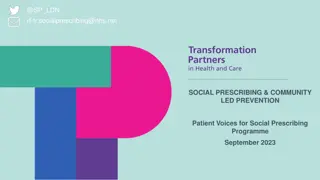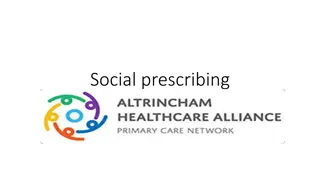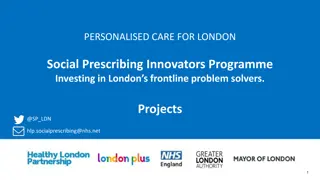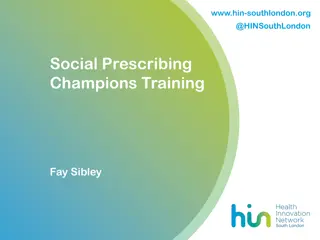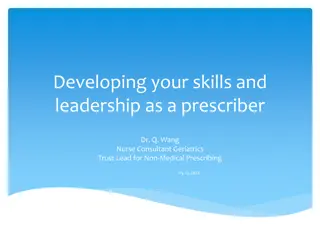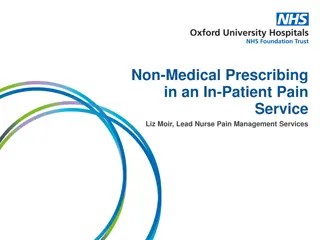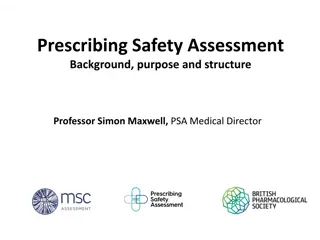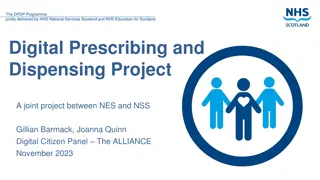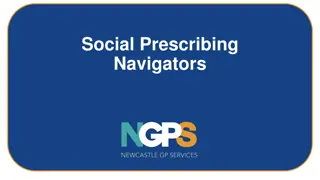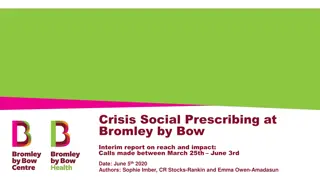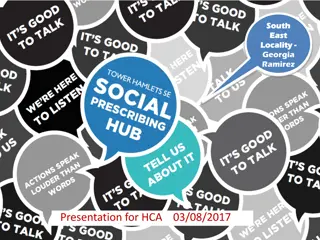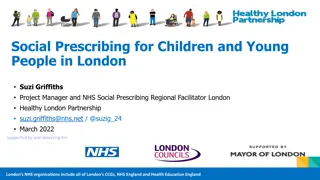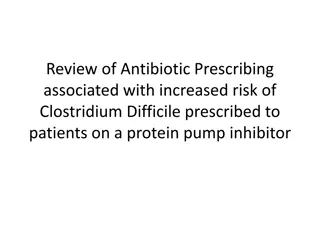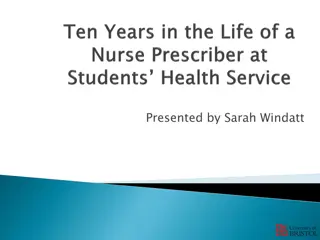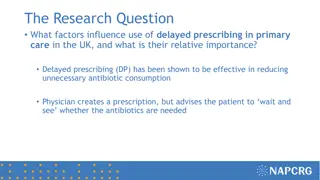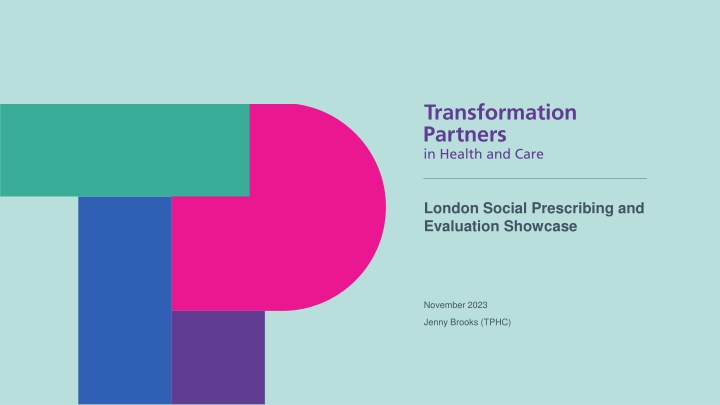
Importance of Evaluating and Demonstrating Social Prescribing Impact
Understanding the importance of evaluating and demonstrating the impact of social prescribing in aligning with NHS targets and mandates for improvement. Learn how evaluation influences decision-making, resource targeting, and inequality tackling, ensuring social prescribing remains a key investment area.
Download Presentation

Please find below an Image/Link to download the presentation.
The content on the website is provided AS IS for your information and personal use only. It may not be sold, licensed, or shared on other websites without obtaining consent from the author. If you encounter any issues during the download, it is possible that the publisher has removed the file from their server.
You are allowed to download the files provided on this website for personal or commercial use, subject to the condition that they are used lawfully. All files are the property of their respective owners.
The content on the website is provided AS IS for your information and personal use only. It may not be sold, licensed, or shared on other websites without obtaining consent from the author.
E N D
Presentation Transcript
London Social Prescribing and Evaluation Showcase November 2023 Jenny Brooks (TPHC)
What is covered today Topic Background importance of social prescribing impact and current activity Time Who 10 min Jenny Brooks (Programme manager TPHC) Katy Knight - Senior Evidence and Evaluation Specialist NASP) Anthea Terry - (Head of Evidence and Evaluation NASP) Lauren Moy (Programme manager - NEL ICB) Raquel Cerezo Martin (Social prescribing link worker Redbridge) Lisa Wolff (Social prescribing link worker Havering) Victoria Tzortziou-Brown (GP Tower Hamlets, NHS NEL ICB Research and Innovation Lead) Caitlin Bays (SP manager - Age UK) Seher Kayikci (Public Health Barnet) Denys Rayner (Project Manager Minimum Data Set Content & Launch NHS England) National Academy of Social Prescribing - our commitment to social prescribing evidence and impact 5 min Join the Slido to share your reflections throughout Live example - an ICB wide approach in North East London Template for capturing SP data and dashboard Perspective from a social prescribing link worker Impact of SP data from a GP perspective Live example a borough wide reporting approach in Barnet, led by Age UK social prescribing service 15 min 15 min Slido.com The minimum dataset 10 min #SPEVAL Jenny Brooks (Programme manager TPHC) Q&A 15 min Jenny Brooks (Programme manager TPHC) Hosted by our speakers Social Prescribing reporting for services Caitlin Bays The national minimum data set Denys Rayner Supporting voluntary sector impact Katy Knight and Anthea Terry ICB support for SP impact Lauren Moy Next steps 15 min Breakout rooms - topical discussions hosted by our speakers 20 min Close
Why is evaluation and demonstrating the impact of Social Prescribing important? These ambitions align with core NHS targets, mandates and plans for improvement, including: Supports investment in social prescribing and prevention across sectors, particularly VCSE ICB statutory requirements Hewitt ICS report ICB/ICP integrated care 5 year strategies, informed by joint needs assessments Influences decision making and better targeting of resource to tackle inequality Enables better understanding of local populations, development of shared insight for effective neighbourhood teams PCN DES, Personalised care and Health Inequalities Supplement Ensure social prescribing remains business as usual by evidencing value Modern general practice Plan for recovering access to primary care Fuller Stock Take report National NHS Inclusion health framework CORE20PLUS5 Read our summary slides on policies, with key messages here.
What were doing in London Social Prescribing and Evaluation Community of Practice Monthly sessions sharing best practice, holding discussions and helping co-producing plans for regional support in this area Open to all roles at any level. Get in touch if you d like to join. We are reviewing the group in the new year. Upcoming support to be released early 2024 The London Social Prescribing Evaluation Toolkit Plans and content co-produced with a group of SPLWs, managers and PCN managers What this has led to Case studies and mapping of examples to be published soon Paper on how VCSE and Health can work together to demonstrate impact Currently developing content with the system Social Prescribing and Evaluation case study series Working with Office of National Statistics to identify improvements to ONS-4 We held a London wide feedback session, which provided amazing insight Now we are planning activity in response to feedback to support use of ONS-4 nationally Detailed examples of: How social prescribing is being evaluated across London What is supporting services to evaluate
NCL Developed list of recommended patient outcome measures for SP Looking at what outcomes are being captured across different boroughs to understand how consistency could be improved ICB wide use of MyCaw as part of Long Terms Conditions work within personalised care support planning. Wide variety of case management systems being used Supports Pop health strategy NEL Pilot site for National Minimum data set work Developed template for EMIS/SystmOne/Joy including minimum dataset and extra information Data is feeding into the ICB wide PowerBI dashboard They hold a regular evaluation group focused on embeddingr data collection into SPLW consultations and data analysis using the dashboard Barnet, Age UK: Borough wide system for regular reporting SP data. Working with public health on yearly report and GP attendance yearly report, linking data. Elemental shares a gap report about services with SPLWs. NWL Camden: Working to embed evaluation in VCSE employers and SP, working with UCL evaluation exchange Commissioning Joy across all boroughs for Social Prescribing Working with NAPC (National Association of primary care) on evaluation. Action Learning Sets being undertaken with each borough to look at: Controls: Tools and Technology within the work systems; Colleagues: People's behaviours, the process used, culture of MDTs etc; Caseloads: patient management, task generation, onwards support, patient activation. Evaluation frameworks being designed by 3ST (VCSE alliance) and the Bi-borough partnership Tower Hamlets: Co-produced 6 outcome, 40 indicator measure what makes a good life (BBBC). Rolling this out for SPLWs and wider. Harrow: Used data from Joy on services, to support recommissioning of Housing support Lambeth: Social prescribing innovators project designed a process for evaluation with SPLWs at the core including joint staff and resident feedback forums, and yearly report Westminster: Holding borough wide group for all connector roles called Octopus, now looking at KPIs for services, to show impact Merton: Undertook separate evaluations of HWBCs and SPLWs Hammersmith and Fulham: Healthwatch is carrying out an evaluation of the SP service Bromley: Collecting monthly cumulative referrals via EMIS (GP fed) SP activity providers are running their own evaluation Bromley Well. Healthwatch evaluation of SP service at the patient, SPLW and GP level Sutton: Procured Joy and has designated a lead to implement the system. Southwark: Feedbacks data on gaps across borough to ICBs to inform commissioning through SP oversight group.
NASP Evidence Team 29th London TPHC Showcase Event Anthea Terry NASP Head of Evidence and Evaluation Katy Knight Senior Evidence and Evaluation Specialist Evaluation specialism 6
What we will talk about today What do we know about VCSE evaluation of social prescribing and how to support it? What is NASPs role in social prescribing evidence and evaluation? What are the opportunities for collaboration?
What is NASPs role in social prescribing evidence and evaluation? We bring stakeholders together to share knowledge, identify and address evidence gaps, research challenges and opportunities through collaboration, being convenors and communicators of evidence, and increasing capability for evidence-based approaches. Page 8
Where does the evidence come from? Academic research Evaluations from other SP projects (private, charitable, other government depts) VCSE provider/ activities Individual Referrer Link worker function NHS data, various sources/systems and scales: E.g. GP appts; SNOMED codes; secondary care admissions, etc. Evaluations Small scale Variable Non-specialists NHS patient records Demographics Social determinants (e.g. deprivation) Other contextual factors
Highest priority needs Develop better ways to report on the economic value of social prescribing in the UK Support VCFSE organisations in the UK to deliver evaluations of social prescribing that are of use to them and to their commissioners socialprescribingacademy.org.uk/evidence-on-social prescribing/ Sign up to the evidence collaborative here.
Supporting the VCFSE sector to evaluate social prescribing Dr Marie Polley, Abby Sabey, Dr Helen Seers, Professor Helen Chatterjee Rapid scoping review aimed to: o Identify and collate resources to support evaluations of SP programmes o Assess the appropriateness/quality of these resources Headlines: o 61 resources identified that met inclusion criteria 15 comprehensive toolkits 13 partial toolkits 33 resources focused on one aspect of evaluation o Developing a shared language across sectors could facilitate a more consistent approach (glossary of evaluation terms could be produced) o Difference in cultures across funders/sectors is a limitation on evaluation activity o A range of learning and training needs were identified
What next? What works for whom? Better evidence on: particular population groups specific conditions health inequalities for both intervention and implementation Consistency and consensus Simple, consistent impact measures for evaluation Gold standard measures for economic impact/service usage Data sharing Alternative ways to evaluate
Live example - an ICB wide approach in North East London Lauren Moy (Programme manager - NEL ICB) Raquel Cerezo Martin (Social prescribing link worker Redbridge) Lisa Wolff (Social prescribing link worker Havering) Victoria Tzortziou-Brown (GP Tower Hamlets, NHS NEL ICB Research and Innovation Lead)
Minimum dataset Template & Dashboard 14 SP Teams across 45 PCNs Social Prescribing Evaluation Group Minimum dataset Dashboard Procurement of CMS / DoS EMIS/SystmOne template Improvement cycle Quality Improvement
Social Prescribing Reporting and Evaluation in Barnet Caitlin Bays - Social Prescribing Manager Seher Kayikci - Senior Public Health Strategist 29/11/23
Barnet SP Reporting Case Management System: Elemental (Funded by PH and ICB) Reporting duties: SP Manager (Age UK Barnet) Report Recipients: PCNs, Barnet Federated GPs, Public Health, Age UK Barnet, ICB and Health and Wellbeing Board. Frequency: Monthly, Quarterly and Annually. Types: Excel and Presentation formats. Content: Service Utilisation, Referral Reasons, Appointment information, Demographics, Onward Referrals, Outcomes, Feedback, Gaps in services, Updates.
Evaluation Annual cycle of evaluation conducted by Public Health. Purpose: 1) Patient outcomes: Measured via ONS 4, demonstrates personal well-being on the four outcomes measures satisfaction, worthwhile, happiness and anxiety. In addition, patient feedback survey results. 2) Impact evaluation: analysis of EMIS data, demonstrates the benefits of the service to the system GP and A&E attendance. Limitations / Challenges: Outcomes include GP attendance reviews which are manually done through EMIS EMIS access is limited for analytic staff not directly employed by PCN. Covid 19 skewed data analysis for the early years of the service.
Evaluation: Impact for the PCNs and the Service Showcase the value of the service and made a case for embedding Social Prescribing into PCNs as well as outlining where higher engagement is needed. PCNs use the reports to support project work (e.g. health inequalities, winter pressures etc) and provide insight into the needs of their population. Measuring patient outcomes helps identifying successes and improvements needed in our service (ONS, GP attendance and feedback survey - asks patients how we can improve our service).
Wider Impact of the Reports Annual cycle of reporting to the Health and Wellbeing Board to raise of awareness of the needs and to demonstrate success of the service. Public Health used the reports for informing the Community Innovation Funding decision making. The funding is used where higher needs are. Social Prescribing reports are used to generate discussions to develop borough s Neighbourhood Model across the ICB, the Council and VCSE. Helps identify needs and trends, informing local commissioners and projects such as: MH transformation, Healthwatch, Adult social care commissioners. Using these report to understand, Utilisation and needs and onwards signposting and resources suggested. Community organisations have used the reports to help identify service needs in the borough, for example, Age UK Barnet have responded to fulfil a service gap identified for older adults as well as sharing knowledge and insight to the Age-Friendly Barnet programme.
The Minimum Dataset and Information Standard The background and rationale behind the launch of the new Social Prescribing Minimum Data Set and Information Standard 20 |
What is the Information Standard? The Social Prescribing Information Standard has been designed to aid the sharing and recording of information for the whole patient journey. This is from an initial referral, includes the various meetings and support offered through to the message back to the referrer and GP at its conclusion. The standard is all about the recording and sharing of information within social prescribing which includes: Information required to support the conversations between the link worker and the client Information to support people, showing that their healthcare is joined up and avoids them having to retell their story multiple times Providing information that can be shared with the person themselves, their family or carer Summary information back to the referrer and GP for the person s overall record Information for commissioning uses, e.g. to understand the scale and effectiveness of social prescribing services, aid future planning and support population health initiatives etc. 21 |
Why has the Information Standard been created? Our health and care information isn t all recorded in a single place but in many different systems. When we go to hospital or to a GP surgery, a record of the conversation between the person and clinician is made, including any decisions and actions taken. Records are created in other settings too, such as care homes. A care and support plan agreed between the resident and care home staff is recorded in a care home record system. People access care in many more settings today than they ever did before, and for professionals and people themselves to have a complete picture of a person s health and care, we need to join all these many records together, so information follows the person whenever and wherever care is provided Recording information consistently For information to flow between systems, it needs to be organised and recorded in the same way every time. Agreed national standards and definitions must be used so that any computer can reproduce it with the same meaning. Right place, right time When information standards are implemented by care providers and their computer system suppliers, information will be recorded consistently across different settings. This enables meaningful information to be made available to the right professionals at the right time, so it can be used to inform decisions about the care of the person. Information tailored for different needs Not everyone we interact with needs to see all the information in these records to advise us on what tests we might need, or diagnose a condition, or meet our care and support needs, but they might need to see some information from more than one record.
What is the Minimum Data Set? The Minimum Data Set is a sub section of the Information Standard and consists of four sections of terms supported by SNOMED codes. These sections are: Demographic information Needs & Concerns Support Measures There are now 78 agreed terms (excluding outcomes) that provide descriptions with the aim to collect these nationally These are all available on the various core GP IT systems and on recommended Social Prescribing specific systems, and if used they can record the terms and coding We know that there will be some SPLWs who do not have access to these systems, however it will be possible either to collect them manually in a data sheet or via a template such as Ardens As there are only a limited number of codes the terms are at a high level so it is understood that they will have to be interpreted as the best fit and you may wish to add additional terms for your own benefit It is intended to add to the data set in time following experience of the roll out 23 |
Why are we doing this? One of the key aims is to ensure that the person only needs to provide their information once and this is expected to greatly improve their experience This will help any clinician supporting the individual to see their overall needs in their care plan, and will improve their understanding in future consultations to provide the best care Commissioners will have a better understanding of the needs and support required of a locality to ensure that they are providing the right support It will benefit Link workers by demonstrating the benefits of the work that they are doing to the wider system and profiling the value of the service Many link workers are concerned that their referrers do not always understand the work that they are doing and this will help improve the awareness and support better referrals and feedback using simple dashboards With the roll out of Population Health and the reliance on SPLWs to support the initiatives this will improve the data provided to support the various initiatives within communities This will be the first time that there has been an opportunity to provide national feedback on the work that Social Prescribers are doing 24 |
How did we develop the terms? This piece of work has been 3 years in the making We have engaged with stakeholders consisting of those with lived experience, link workers, business managers, regional teams, researchers and other social prescribing professionals In addition, we have worked with the major software suppliers to ensure that they are ready to support the MDS There have also been several pilots nationally and linking into the experience of well-respected long-term practitioners who have helped us refine the terms We also looked at existing SNOMED codes and sought to not duplicate where at all possible We have however developed several new codes for this exercise
Minimum Dataset Terms Minimum Dataset Terms Demographic Information: NHS NUMBER POSTCODE OF USUAL ADDRESS PERSON BIRTH DATE PERSON STATED GENDER CODE ETHNIC CATEGORY CODE 2001 Requires reasonable adjustment for health and care access (Equality Act 2010) PERSON MARITAL STATUS Pregnant Religious or other belief system affiliation Sexual orientation Caring status Young Carer? Needs & Concerns Continued: Parenting problem Patient themselves providing care (finding) Social isolation (finding) Feeling lonely Problem related to social environment Bereavement due to life event Employment problem Not in employment, education or training Housing unsatisfactory Homeless Transport problem Unsatisfactory living conditions Low income Difficulty with money management Difficulty obtaining food Unable to heat home Education problem Support: Structured physical activity programme Support for self management Transport education, guidance and counselling Finances education, guidance, and counselling Houses education, guidance, and counselling Bereavement counselling Advice about benefits Employment support Support with volunteering Support for parent Abuse counselling Social care Emotional and psychosocial support and education Advice about support groups Needs & Concerns: Mental Health problem Physical Health problem Mobility Ddrugs Unhealthy alcohol drinking behavior Overweight Underweight Diet poor Chronic pain Dyssomnia Needs assistance with shopping Needs assistance at home Lack of exercise Victim of domestic abuse Victim of discriminatory abuse Difficulty communicating Unable to perform information and communication technology activities Relationship problem
Minimum Dataset Terms continued Minimum Dataset Terms continued Measures continued: Warwick-Edinburgh Mental Wellbeing Scales Assessment using Warwick-Edinburgh Mental Well-being Scale 14-item scale WEMWBS score 2. Overall, to what extent do you feel that the things you do in your life are worthwhile? 3. Overall, how happy did you feel yesterday? 4. On a scale where 0 is not at all anxious and 10 is completely anxious , overall, how anxious did you feel yesterday? Assessment using Short Warwick-Edinburgh Mental Well-being Scale 7-item scale WEMWBS score Support Continued: Caregiver support Help with household management Social support Counselling Alcohol abuse prevention education Drug abuse prevention education Health promotion education Healthy eating advice Signposting to training resource Signposting to Volunteering activity Support to creative activity Signposting to nature-based activity Signposting to childcare support resource Signposting to peer support resource Signposting to debt advice resource Signposting to education resource Personalised Care: Referral to social prescribing service Social prescribing declined Social prescribing case closed Seen by health and wellbeing coach Seen by care coordinator Personalised Care and Support Plan agreed Review of Personalised Care and Support Plan Shared decision making Has personal health budget Measures: National Wellbeing measure (ONS4) Assessment using Personal Wellbeing Score 1. Overall, how satisfied are you with your life nowadays? 2. Overall, to what extent do you feel that the things you do in your life are worthwhile? 3. Overall, how happy did you feel yesterday? 4. On a scale where 0 is not at all anxious and 10 is completely anxious , overall, how anxious did you feel yesterday?
Next steps 1. We will distil themes from today, share recording and key messages 6th December NASP the latest evidence for social prescribing webinar 2. 3. Share any answers to questions we ve taken away Look out for the Social Prescribing and Evaluation Toolkit and contribute any examples, reports to be featured 7th December - data management in general practice -NHS/PRSB looking at standardising the recording type of encounter/consultation, such as face-to-face consultations in the surgery, to improve the data available to practices, commissioners to support planning 4. Get in touch if you d like us to develop an in depth case study on how you are measuring or reporting social prescribing impact in your area jennifer.brooks14@nhs.net
Choose what room to join by following the links in the teams chat 1. Social Prescribing reporting for services Caitlin Bays 2. The national minimum data set Denys Rayner 3. Measuring impact and the VCFSE Katy Knight and Anthea Terry 4. ICB support for SP impact Lauren Moy 5. The Social Prescribing Evaluation Toolkit Jenny Brooks (stay in the main room)
Themes from breakouts Social Prescribing reporting for services Caitlin Bays People were interested in what are the benefits of different case management system. How do you evaluate when you don t have one? Who to raise the importance of having a case management system with for social prescribing and make the case? What influence do case management systems have and how can we use this to make the case for investment in areas that don t currently have a case management system? ICB support for SP impact Lauren Moy Shared where funding came from for dashboard used Digital First for ICB work and local authorities for case management systems . Bringing SP data, GP data and secondary care data together to do the analysis and in the dashboard Discussed cohorts and long term conditions Measuring impact and the VCFSE Katy Knight and Anthea Terry More training and skills building would be useful, especially for small VCSE organisations Frustration that data is discussed at a level which is very different from small activity organisations difficult for them to know what to gather and what would be useful Tricky when its 1000s of different groups, should umbrella VCSE orgs support how they can enable How can faith groups collaborate Who and where does responsibility lie ICB/LA/VCSE? it isn t clear who should be driving and who is doing what The national minimum data set Denys Rayner Discussed SP outcomes Working with people with low level mental health- how do we document impact on this cohort and frequent flyers Terminology is very high level and there isn t much around CYP and CYP mental health specifically Data requirements will evolve depending on what questions are being asked and what we need to answer
Resources NASP Evidence resource database Specific resources This NASP webinar gives a comprehensive introduction to evaluating a social prescribing service. This practical guide outlines how you can measure impact on wellbeing, focusing on community and voluntary sector. A wealth of tools were created by The Inspiring Impact programme by NPC to support the community and voluntary sector to better collect, use and evaluate data.

